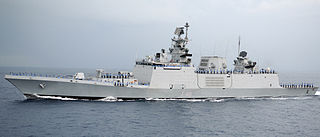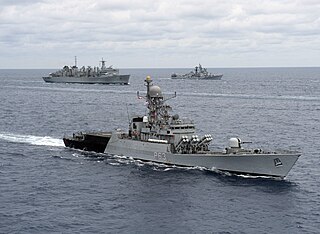
The Indian Navy is the maritime branch of the Indian Armed Forces. The President of India is the Supreme Commander of the Indian Navy. The Chief of Naval Staff, a four-star admiral, commands the navy. As a blue-water navy, it operates significantly in the Persian Gulf Region, the Horn of Africa, the Strait of Malacca, and routinely conducts anti-piracy operations and partners with other navies in the region. It also conducts routine two to three month-long deployments in the South and East China seas as well as in the western Mediterranean sea simultaneously.

USS John S. McCain (DDG-56) is an Arleigh Burke-class destroyer currently in the service of the United States Navy. She is part of the Destroyer Squadron 23 within the Third Fleet, and has her homeport at Naval Station Everett in Everett, Washington.

The Rajput-class guided-missile destroyers built for the Indian Navy are modified versions of Soviet Kashin-class destroyers. They are also known as Kashin-II class. The ships were built in the former Soviet Union after considerable Indian design modifications to the Kashin design. These included the replacement of the helicopter pad in the original design with a flight elevator, as well as major changes to the electronics and combat systems. Five units were built for export to India in the 1980s. All units are currently attached to the Eastern Naval Command.

INS Rana is a Rajput-class destroyer in active service with the Indian Navy. She was commissioned on 28 June 1982.

INS Ranvijay is a Rajput-class destroyer in active service with the Indian Navy. Ranvijay was commissioned on 15 Jan 1988.

INS Kolkata is the lead ship of the Kolkata-class stealth guided-missile destroyers of the Indian Navy. Named after the Indian city of Kolkata, she was constructed at Mazagon Dock Limited (MDL) and was handed over to the navy on 10 July 2014 after completing her sea trials. The ship was officially commissioned by Prime Minister Narendra Modi in a ceremony held on 16 August 2014.

The Shivalik class or Project 17 class is a class of multi-role stealth frigates in service with the Indian Navy. They are the first stealth warships built in India. They were designed to have better stealth features and land-attack capabilities than the preceding Talwar-class frigates. A total of three ships were built between 2000 and 2010, and all three were in commission by 2012.

Kora-class corvettes are guided missile corvettes, in active service with the Indian Navy and the National Coast Guard of Mauritius. Four vessels were built at Garden Reach Shipbuilders and Engineers (GRSE) and outfitted at Mazagon Dock Limited (MDL).

INS Shivalik (F47) is the lead ship of her class of stealth multi-role frigates built for the Indian Navy. She is the first stealth warship built by India. She was built at the Mazagon Dock Limited (MDL) located in Mumbai. Construction of the vessel began in 2001 and was completed by 2009. She underwent sea trials from thereon before being commissioned on 29 April 2010.

The Komandarm Fedko class is a class of replenishment tankers operated by the Indian and Chinese navies. Four ships of the Komandarm Fedko class were constructed by the Soviet Union, later Russia, of which one was bought by India, one by China and two are in commercial service. INS Jyoti is the third largest ship in the Indian Navy after the aircraft carrier INS Vikramaditya.

Exercise Malabar is a naval exercise involving the United States, Japan and India as permanent partners. Australia rejoined the exercise in 2020. The annual Malabar exercises includes diverse activities, ranging from fighter combat operations from aircraft carriers through maritime interdiction operations, anti-submarine warfare, diving salvage operations, amphibious operations, counter-piracy operations, cross–deck helicopter landings and anti–air warfare operations. Over the years, the exercise has been conducted in the Philippine Sea, off the coast of Japan, the Persian Gulf, in the Bay of Bengal and the Arabian Sea. It is taken care by the Asian and the North American Commands.
The Andaman and Nicobar Command (ANC) is the only tri-service theater command of the Indian Armed Forces, based at Port Blair in the Andaman and Nicobar Islands, a Union Territory of India. It was created in 2001 to safeguard India's strategic interests in Southeast Asia and the Strait of Malacca by increasing rapid deployment of military assets in the region. It provides logistical and administrative support to naval ships which are sent on deployment to East Asia and the Pacific Ocean.

INS Kulish is a Kora-class corvette, currently in active service with the Indian Navy. She was ordered in October 1994 and the keel was laid in October 1995. The ship was launched in August 1997 and was commissioned on 20 August 2001.

INS Karmuk is a Kora-class corvette, currently in active service with the Indian Navy.

INS Talwar (F40) is the lead ship of the Talwar-class frigates of the Indian Navy. Its name means "Sword" in Hindi. She was built in Russia, and commissioned into the Indian Navy on 18 June 2003.

INS Shakti (A57) (Strength) is a Deepak-class fleet tanker in service with the Indian Navy. She was built by Fincantieri, an Italian shipbuilding company based in Trieste. She is the second and final ship of her class. Shakti, along with her predecessor Deepak, is one of the largest ships of the Indian Navy.

Theatre Level Operational Readiness Exercise (TROPEX) is an inter-service military exercise involving the participation of the Indian Army, Air Force, Navy and the Coast Guard. The exercise generally commences at the beginning of each year and lasts a month. It is generally carried out in three phrases: independent workup phase, joint workup phase and tactical phase.
INS Batti Malv (T67) is the 3rd ship of the Bangaram-class patrol vessels of the Indian Navy, designed for interdiction against fast moving surface vessels and for search-and-rescue operations in coastal areas and in the exclusive economic zone. Named after the Battimalv Island in Nicobar, the vessel was designed and built by Garden Reach Shipbuilders and Engineers. The diesel generators on board are supplied by Cummins India. The electronic equipment on board including satellite communication and global positioning systems is from Bharat Electronics Limited, ECIL and Hindustan Aeronautics Limited.

Admiral Radhakrishnan Hari Kumar is a serving flag officer in the Indian Navy. He is the 25th and current Chief of the Naval Staff (CNS). Previously, he served as the Flag Officer Commanding-in-Chief, Western Naval Command. In his prior appointments, he served as the Chief of Integrated Defence Staff, Chief of Personnel, Controller Personnel Services, the Flag Officer Commanding Western Fleet, Flag Officer Sea Training and the Chief of the Staff of the Western Naval Command. He was the Commandant of the Naval War College, Goa and served as a naval advisor to the government of Seychelles. He is an alumnus of National Defence Academy, the Naval War College, the Army War College, Mhow and the Royal College of Defence Studies.




















